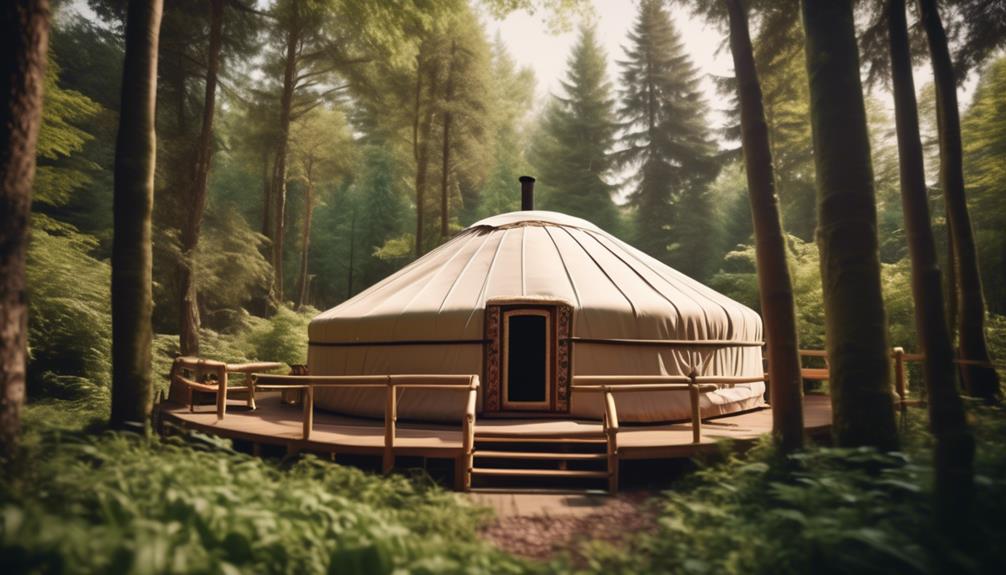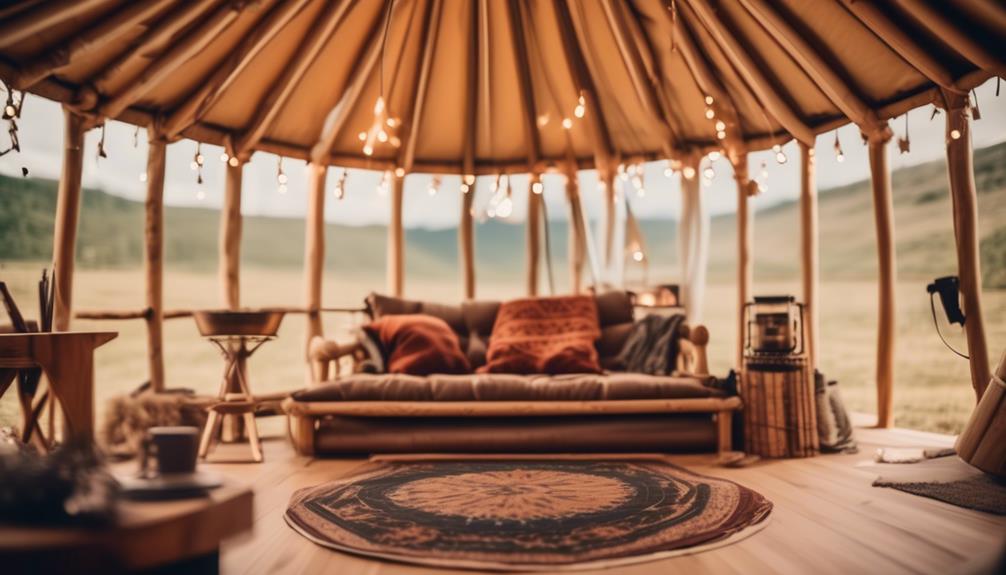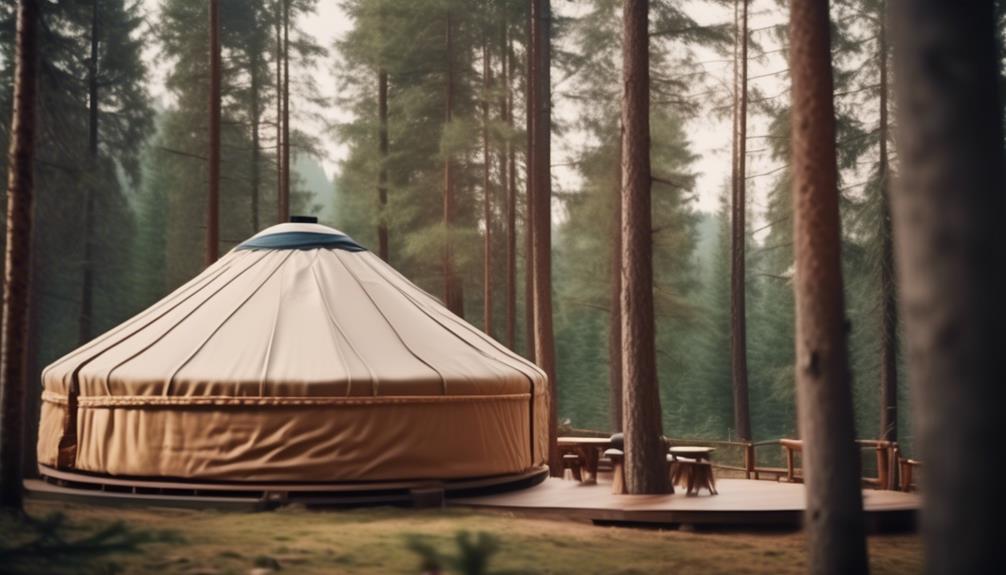When considering alternative housing options, the cost is often a primary concern for many individuals. Yurts, with their unique blend of portability and functionality, have gained popularity in recent years. However, determining how much a yurt costs can be a complex task, as it depends on several factors. In this discussion, we will explore the various elements that affect yurt prices, such as the cost of materials, additional features and upgrades, as well as the different size and design options available. By the end, you will have a clearer understanding of the average price range for yurts and the factors to consider when making this unique investment.
Key Takeaways
- Location, size, materials, and additional features all contribute to the cost of a yurt.
- Wood is durable but expensive, while canvas is affordable but requires maintenance.
- Insulation materials, flooring, doors, and windows can add to the overall cost of a yurt.
- Consider specific needs and preferences when choosing the size and design of a yurt, as larger yurts are more expensive to purchase and maintain.
Factors Affecting Yurt Prices

The cost of a yurt is influenced by various factors. When considering the pricing trends of yurts, it is important to take into account the materials used, the size of the yurt, and the additional features or customization options chosen by the buyer. These factors can greatly impact the overall cost of the yurt.
One of the key factors affecting yurt prices is the type and quality of materials used in its construction. Yurts can be constructed using a variety of materials such as wood, canvas, or even modern synthetic materials. The choice of materials can significantly affect the durability, longevity, and aesthetic appeal of the yurt, thus influencing its price.
Additionally, the size of the yurt is another crucial determinant of its cost. Larger yurts require more materials and labor for construction, which can drive up the overall price. Conversely, smaller yurts may be more affordable, making them a suitable choice for those on a budget.
Comparing yurt costs across different regions is also important. The cost of yurts can vary depending on the location and local market conditions. For example, yurts may be more expensive in urban areas where demand is higher, compared to rural areas where labor and material costs may be lower. Additionally, certain regions may have specific regulations or building codes that can impact the cost of yurt construction.
Cost of Yurt Materials
The cost of yurt materials is a significant factor in determining the overall price of a yurt. When it comes to constructing a yurt, there are various materials to consider, each with its own pros and cons.
One of the primary materials used in yurt construction is wood. Wood is a popular choice due to its durability and natural aesthetics. It provides a sturdy framework for the yurt and can withstand various weather conditions. However, the cost of high-quality, sustainably sourced wood can be quite expensive.
Another material commonly used in yurts is canvas. Canvas is known for its breathability and ability to regulate temperature, making it a suitable choice for yurt walls and roofs. It is also relatively affordable compared to other materials. However, canvas may require regular maintenance and replacement over time.
Insulation materials play a crucial role in keeping the yurt comfortable throughout the year. Options such as wool, foam, and reflective insulation can be used to maintain an ideal temperature inside the yurt. Wool, for instance, is a natural and sustainable option, but it can be costly.
Additionally, the cost of other materials, such as flooring, doors, and windows, should be taken into consideration. These elements can enhance the functionality and aesthetics of the yurt but may add to the overall cost.
Additional Yurt Features and Upgrades

After considering the cost of yurt materials, it is important to explore the additional features and upgrades that can further enhance the functionality and aesthetics of the yurt. These features and upgrades not only add value to the yurt but also improve the overall experience of living in one.
One important aspect to consider when upgrading a yurt is insulation. Proper insulation is crucial for maintaining a comfortable temperature inside the yurt throughout the year. There are several insulation options available, including:
- Reflective Foil Insulation: This type of insulation reflects heat away from the yurt during hot summer months and helps retain warmth during colder seasons.
- Spray Foam Insulation: Spray foam insulation provides excellent thermal and sound insulation properties, creating a more energy-efficient and quieter living space.
- Natural Insulation: For those seeking eco-friendly options, natural insulation materials like sheep's wool or hemp fiber can be used. These materials are sustainable, breathable, and provide insulation against both heat and cold.
In addition to insulation, the choice of flooring can greatly impact the comfort and aesthetics of the yurt. Some popular yurt flooring choices include:
- Hardwood Flooring: Hardwood flooring not only adds a touch of elegance to the yurt but also provides durability and ease of maintenance.
- Bamboo Flooring: Bamboo flooring is a sustainable and environmentally friendly option that offers a unique and modern look to the yurt.
- Cork Flooring: Cork flooring is known for its natural thermal insulation properties, providing a comfortable and warm surface to walk on.
Size and Design Options for Yurts
When considering the size and design options for yurts, it is important to carefully evaluate the specific needs and preferences of the individuals who will be living in them. Yurt customization options offer a range of possibilities to create a space that is tailored to the unique requirements of its occupants.
One of the key factors to consider is the size of the yurt. Yurts come in various sizes, ranging from small, intimate structures suitable for a couple or small family, to larger yurts that can accommodate a larger number of people. The pros and cons of different yurt sizes should be carefully considered before making a decision.
Smaller yurts are often more cost-effective and easier to heat and cool. They can provide a cozy and intimate living space, perfect for a couple or small family. However, they may lack the space needed for larger families or individuals who require more room for activities or storage.
On the other hand, larger yurts offer more space and flexibility. They can accommodate larger families or individuals who require more space for work or recreational activities. However, they may be more expensive to purchase and maintain, and may require more effort to heat and cool effectively.
In addition to size, the design options for yurts are also worth considering. Yurts can be customized with various features such as windows, doors, insulation, and flooring options. These customization options allow individuals to create a yurt that suits their aesthetic preferences and lifestyle needs.
Average Price Range for Yurts

Considering the various size and design options for yurts, it is important to also understand the average price range for these unique structures. The cost of yurt construction can vary significantly depending on factors such as size, material quality, and the region in which it is being built. Here is a breakdown of the average price range for yurts:
- Basic Yurts: The most affordable option, basic yurts typically range from $5,000 to $15,000. These yurts are often smaller in size and made with more cost-effective materials. They are suitable for those on a tight budget or looking for a simple and functional space.
- Mid-Range Yurts: Mid-range yurts offer a balance between affordability and quality. These yurts usually range from $15,000 to $35,000. They come in various sizes and are constructed with higher-grade materials, providing better insulation, durability, and aesthetics.
- Luxury Yurts: For those seeking a more high-end yurt experience, luxury yurts are available. These yurts can range from $35,000 to $100,000 or more, depending on the customization and premium features. Luxury yurts often include amenities such as high-end finishes, advanced insulation, modern appliances, and luxurious furnishings.
- Regional Price Variations: It is essential to note that yurt prices can vary significantly in different regions. Factors such as labor costs, material availability, and local regulations can impact the overall cost. Yurts in more remote or rural areas may be less expensive compared to those in urban or high-demand locations.
When considering the cost of a yurt, it is important to evaluate your budget, desired features, and the intended use of the structure. By comparing yurt prices in different regions and understanding the various options available, you can make an informed decision that best suits your needs and budget.
Frequently Asked Questions
Are Yurts Suitable for Year-Round Living in All Types of Climates?
Yurts can be suitable for year-round living in various climates, but their effectiveness depends on the specific conditions. In extreme climates, such as very hot or cold regions, additional insulation and weatherproofing may be necessary to maintain comfortable living conditions. Yurts offer advantages such as flexibility, durability, and eco-friendliness. However, they also have limitations, including potential challenges in regulating temperature and moisture levels. It is crucial to carefully consider the pros and cons of yurts in different climates before committing to year-round living in one.
How Long Does It Typically Take to Assemble a Yurt?
The time it takes to assemble a yurt can vary depending on various factors such as the size of the yurt, the skill level of the individuals assembling it, and the specific construction process being followed. Generally, yurts can be assembled within a few days to a couple of weeks. The yurt assembly process typically involves erecting the framework, attaching the walls and roof, and finishing with insulation and interior components. It is important to carefully follow the instructions provided by the manufacturer to ensure a successful and efficient assembly.
Can Yurts Be Customized to Meet Specific Needs or Preferences?
Customization options for yurts allow individuals to tailor their living space to meet specific needs and preferences. This flexibility in design and layout provides numerous benefits for those seeking personalized yurts. By incorporating specific features, such as additional windows, insulation, or unique interior finishes, individuals can create a space that suits their lifestyle and aesthetic preferences. Customized yurts offer the opportunity to create a truly unique and comfortable living environment that reflects the individual's personality and requirements.
Are There Any Additional Costs Associated With Owning a Yurt, Such as Maintenance or Insurance?
When it comes to owning a yurt, it is important to consider the additional costs associated with maintenance and insurance coverage. Maintenance costs can vary depending on factors such as location, climate, and the specific materials used in the construction of the yurt. Regular maintenance may include things like repairing or replacing the roof, treating the wood, and ensuring proper insulation. Additionally, it is advisable to have insurance coverage for your yurt to protect against potential damages or liabilities.
Are There Any Restrictions or Regulations Regarding the Installation of Yurts on Private Property?
When it comes to the installation of yurts on private property, there are certain restrictions and regulations that need to be considered. These regulations vary depending on the local zoning laws and building codes of the specific area. Some areas may require permits or inspections before installing a yurt, while others may have restrictions on the size or location of the structure. It is important to research and comply with these regulations to ensure a smooth and legal installation process on private property.
Conclusion
In conclusion, the cost of a yurt can vary depending on several factors, including the materials used, additional features and upgrades, as well as the size and design options chosen. On average, yurts can range in price from several thousand dollars to tens of thousands of dollars. However, it's important to keep in mind that these figures are just estimates and actual prices may differ. As the saying goes, "You get what you pay for," so it's important to carefully consider your needs and budget when purchasing a yurt.

